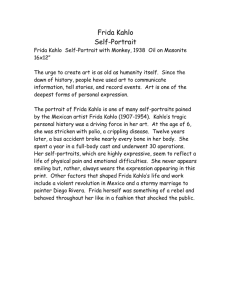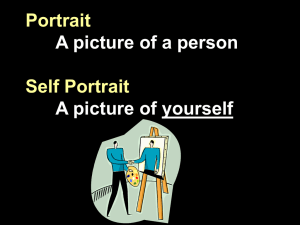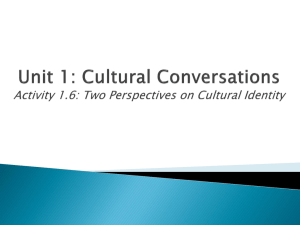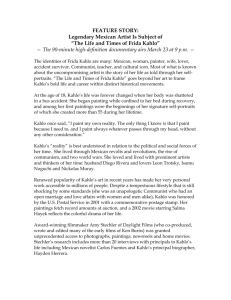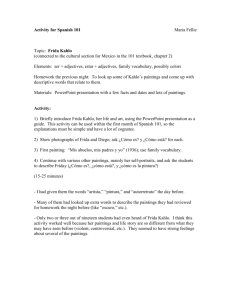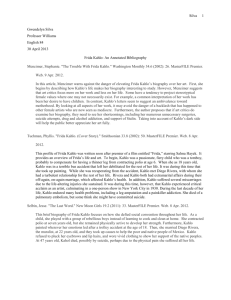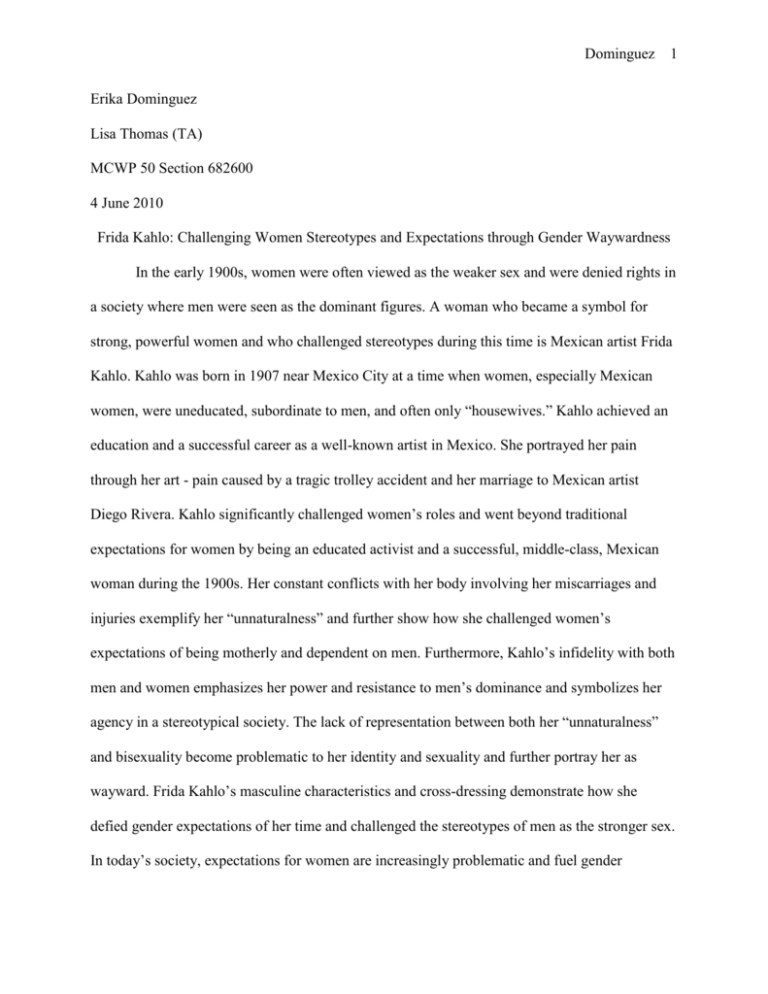
Dominguez
1
Erika Dominguez
Lisa Thomas (TA)
MCWP 50 Section 682600
4 June 2010
Frida Kahlo: Challenging Women Stereotypes and Expectations through Gender Waywardness
In the early 1900s, women were often viewed as the weaker sex and were denied rights in
a society where men were seen as the dominant figures. A woman who became a symbol for
strong, powerful women and who challenged stereotypes during this time is Mexican artist Frida
Kahlo. Kahlo was born in 1907 near Mexico City at a time when women, especially Mexican
women, were uneducated, subordinate to men, and often only “housewives.” Kahlo achieved an
education and a successful career as a well-known artist in Mexico. She portrayed her pain
through her art - pain caused by a tragic trolley accident and her marriage to Mexican artist
Diego Rivera. Kahlo significantly challenged women’s roles and went beyond traditional
expectations for women by being an educated activist and a successful, middle-class, Mexican
woman during the 1900s. Her constant conflicts with her body involving her miscarriages and
injuries exemplify her “unnaturalness” and further show how she challenged women’s
expectations of being motherly and dependent on men. Furthermore, Kahlo’s infidelity with both
men and women emphasizes her power and resistance to men’s dominance and symbolizes her
agency in a stereotypical society. The lack of representation between both her “unnaturalness”
and bisexuality become problematic to her identity and sexuality and further portray her as
wayward. Frida Kahlo’s masculine characteristics and cross-dressing demonstrate how she
defied gender expectations of her time and challenged the stereotypes of men as the stronger sex.
In today’s society, expectations for women are increasingly problematic and fuel gender
Dominguez
2
stereotypes that make it difficult for women to change society’s view of women as the
submissive, weak sex.
Frida Kahlo broke women’s traditional expectations for middle-class Mexican women by
being highly educated and joining a rebellious group in a society where most women never
pursued an education and whose main occupation was to be a housewife. In The Roles and
Attitudes of Modern Urban Modern Middle-Class Women, Roberta H. Miller states, “The vast
majority of all women in Mexico did not have any formal education in the nineteenth century”
(30). Kahlo became an exception to the norm of non-educated women in society, as Isabel
Alcántara and Sandra Egnolff note that she attended school where there were “only about five
girls to three hundred boys” and passed an entry exam “with flying colours” (11). Kahlo’s
intelligence made it possible for her to excel beyond the limitations set for women in society and
to also position herself as an equal to men. Furthermore, by attending a male-dominated school,
Kahlo emphasizes her strength and challenge to male dominance and deviates from society’s
expectations for women. During her years in school, Kahlo “joined a group of overwhelmingly
male student intellectuals called ‘Los Cachuchas’” (14). By placing herself in a position equal to
men, she challenges the idea of women as the weaker sex once again and illustrates her
independence from male authority. The fact that Kahlo joined a group named “Los Cachuchas”
suggests that she presented herself as an equal to her male companions and associated herself
more with males than women, which further shows her agency and power. Claudia Schaefer
describes this group as “expert intellectual debaters as much as practical jokers” who strongly
expressed their intellectual and revolutionary ideas (xxi). Frida Kahlo was known for despising
most of the girls at her school and calling them “escuinclas” (14). This demonstrates her need to
be different and exert her own persona, independent from such stereotypes. By rejecting other
Dominguez
3
girls her age, Kahlo displays her disapproval of society’s expectations for girls and demonstrates
her waywardness by rejecting the feminine side of her character. Kahlo’s assimilation into a
male dominated group contradicts the notion that she was submissive and weak and reflects on
the lack of female organizations and women in school. Though the fact that Frida Kahlo was
dating the leader of Los Cachuchas portrays her tendency to follow society’s expectations by
taking this submissive role of being the girlfriend, it simultaneously portrays her agency and
independence through her active participation and insubordinate actions. Through the group’s
activism, Kahlo projects her waywardness by expressing strong, revolutionary, and intellectual
ideas when, at this time, women had little if any agency. With education and her activism in a
male-dominated rebellious group, Frida Kahlo contradicts the traditional stereotype that a
woman is “incapable of exercising the littlest acts of individual freedom” (Miller 18). Not only
did Kahlo’s intelligence and agency help her succeed in her education, but it set a foundation for
her future success as an artist, defying the expectation for her to be a housewife.
Frida Kahlo’s successful career outside of the home and childcare emphasizes her
strength and agency and makes her a symbol for powerful women by challenging society’s
stereotype that men are the dominant, sole providers for women. Miller describes the traditional
lifestyle of Mexican women during the 1900s and shows how the majority were “housewives”
and seen as the weaker sex (15). Kahlo’s successful career exemplifies how she defied the
traditional roles of women to be “wife and mother while the man was to be her protector and
provider” (2). Her career as an artist greatly portrays Kahlo as a strong woman who entered a
workforce dominated by men. Though Frida Kahlo did follow the tradition to marry, she
disregarded the norm for women to become mothers. The film Frida shows a scene where Kahlo
and her husband are eating mole for breakfast and Kahlo asks Rivera who made the delicious
Dominguez
4
breakfast. Rivera replies by saying that his second ex-wife, Lupe Marin, had made the food.
Kahlo storms out to confront Marin, who says, “If you are going to stay married to him, you
better learn how to make his favorite dish” (Frida). This scene showcases the stereotype of
Mexican middle-class women to serve their husbands and be the stereotypical, submissive
housewives. By asserting that Kahlo needed to know how to make Rivera’s favorite meal in
order to ensure a successful marriage, it shows how society expected women to attend to their
husband’s every need. The film also proves Kahlo’s independence and assertiveness by showing
that she did not make her husband food and did not even know how to cook his favorite dish.
The following scene shows Marin making food in the kitchen and Kahlo helping out, while
Marin and Rivera’s children run around the kitchen. This scene describes the perfect setting of
the stereotypical Mexican woman, in the kitchen making food for the male dominant figure
while taking care of the children. By limiting Kahlo’s participation in the kitchen, this scene
shows how she rejected the idea of being the stereotypical housewife and mother. The film
further depicts Kahlo’s waywardness by exaggerating her extravagant lifestyle of parties,
drinking, and sex, thus emphasizing her freedom and life outside of the domestic world. Thus,
Frida exemplifies Kahlo’s successful career by depicting her art throughout the film and
showing how her success was made possible by her rejection of society’s expectations for
women. The film demonstrates how Frida Kahlo challenged male dominance and how she did
not have the submissive and weak characteristics that women of her class were expected to have.
She showed strength and power by defying traditional gender roles and expectations-traits that
came to define men at this time. Kahlo’s successful career not only showed her independence
and agency but demonstrates how she challenged society’s expectations for vulnerability and
motherhood.
Dominguez
5
Kahlo’s multiple miscarriages portrayed her as being “unnatural,” challenging society’s
expectations for motherhood and defying gender expectations for women to be vulnerable and
inferior to men. Through her art, Kahlo portrays her inability to be a mother and shows how she
could not fulfill her “natural” duty. Kahlo used her art as a way to express her agency and power,
which reinforces her deviance from the stereotypical vulnerable, inferior woman. Kahlo’s
portrait The Birth (1932) shows a woman lying down on a bed, the upper half of her body
covered with a white blanket and exposing her lower half, showing a baby’s head coming out of
the woman’s bloody vagina. The baby is dead and appears to be the face of Frida Kahlo herself.
Aside from mother and child, the only other person in the room is Mater Dolorosa who appears
to be weeping in a portrait above the bed. This portrait reflects the private moment of birth
between mother and child, which demonstrates Kahlo’s tendency to display private matters to the
public and portray her pain through her art. Bakewell claims that a woman’s open anatomy
makes a woman vulnerable, susceptible to injury, and places her in a negative perspective (174).
Kahlo’s tendency to embrace private matters in her art, such as the nude and the vagina shows
how she celebrated the female anatomy and how she portrayed it in a positive way, thus
challenging the stereotype that female anatomy makes women vulnerable. It depicts her as being
“unnatural” since she embraced the vagina and used her art to exemplify her agency, but
“unnatural” does not necessarily signify something negative or a failure. This portrait challenges
women’s inferiority and presents them as positive figures rather than submissive beings, further
describing Kahlo as being a fierce women despite her “unnatural” miscarriages. Barbara Hillyer,
author of Feminism and Disability, describes how “‘natural’ has been used to confine women to
the private, domestic sphere in contrast to men” (165). By breaking this idea of “natural,” Kahlo
breaks the expectation of women and the “domestic sphere,” thus showing how she challenged
Dominguez
6
society’s expectation of women to live in the world of housewifery and childcare. By positioning
herself on an equal level with men, by being successful, and by not having children, she opposes
the expectation of men to be the dominant figure and the provider. Like her miscarriages, other
body issues such as her multiple injuries Kahlo’s tendency to reject society’s idea of a woman
and prove her strength in spite of adversity.
Frida Kahlo’s conflicts with her body and in particular her multiple injuries, emphasize
her strength and independence from men as well as her challenge to the stereotype that women
are the weaker sex. In society, “mourning is treated as weakness or self-indulgence” (Hillyer 79).
Kahlo was struck with polio as a child, leaving one leg thinner than the other, and experienced a
tragic trolley accident that led to more than thirty-five surgeries (Schaefer 4). By portraying her
pain and mourning through her art, Kahlo demonstrates her strength by challenging the notion
that disabled women are weak or self-indulgent and by arguing that mourning is not necessarily
weak. She displayed traits that were strong, “macho,” and inspiring - traits that defined only men
at this time. Kahlo’s constant use of blood and flesh in her art is a representation of human
survival, rather than spiritual anguish (Bakewell 173). The Birth (1932) represents Kahlo’s use of
blood and flesh in her art, which reflects Frida Kahlo’s tendency to portray her pain in her art
and make bold statements that capture her agency. By painting vulgar portraits that were
unconventional and viewed as masculine, Kahlo emphasizes her strength and rejects society’s
ideologies. The portrait symbolizes human survival throughout adversity and showed Kahlo’s
will to keep fighting after her multiple injuries. Miller states that dependence is seen as a
negative trait in society and that it becomes problematic when dependence is associated with
how much strength a woman has (196). The film Frida portrays Kahlo as very independent,
which shows how she challenged the stereotype of being weak and submissive. In one of the
Dominguez
7
scenes, Kahlo is in a wheelchair and has not walked for months. The film shows that she stands
up from the wheelchair and walk towards her father without any help from anybody. Though the
fact that she is walking towards the dominant figure in her life might signify her dependence on
her father, she rejects his attempt to help her and exerts her independence by walking without
anybody’s help. Kahlo demonstrated independence as a woman and proved her strength and
power, thus challenging male dominance and society’s expectations for her to be weak and
fragile. Such characteristics led her to reject male authority and defy her husband’s attempt to
control her multiple affairs.
Frida Kahlo’s infidelity with both men and women reflects her independence as a woman
and emphasizes both her agency and resistance to men’s dominance by demonstrating how her
bisexuality and multiple affairs broke expectations for women at that time. Kahlo is greatly
known for her bisexual affairs and her problematic relationship with her husband, especially
during a time when society upheld expectations for women to be pure. Miller states,
“Traditionally, women had to be faithful, pure, and respectful of their husbands, while men did
not” (19). Not only was Kahlo having affairs with men and women, she ignored her husband’s
authority and disrespected his denunciation of her heterosexual affairs. This shows how Kahlo
constantly resisted male dominance and how she exhibited her agency by going against society’s
expectations for women to be faithful, pure, and respectful. The film Frida portrays Kahlo’s
bisexuality and demonstrates how society’s stereotypes perpetuate this conflict between men’s
infidelity vs. women’s infidelity. The film significantly shows the active role that jealousy
played in Kahlo and Rivera’s marriage and emphasizes that Rivera was jealous of Kahlo’s
heterosexual affairs but not of her homosexual ones. The way the film describes Rivera’s
jealousy emphasizes how society sexualizes women and demonstrates that women can resist
Dominguez
8
male dominance and authority as long as they are accepted by society’s standards. It argues how
women are seen positively when engaging in homosexual affairs but are looked down upon by
society when having heterosexual affairs. Rivera’s jealousy of her heterosexual affairs
demonstrates how he is threatened by other men, but not so much by other women, reflecting on
the stereotype that men are the dominant figure and must be macho in a relationship. There is a
scene in Frida where Kahlo and Rivera are in the market and are both making sexual jokes about
the other person’s anatomy. By showing Kahlo this way, the film argues that Kahlo put herself
on a level equal to her husband and demonstrates strong characteristics that allowed her to
deviate from the respectable and pure nature of women at this time. It reinforces the idea that
men control what is acceptable in society, thus limiting women’s freedom and choices. It shows
how sexuality gives women certain leverage and more choices since men and society view
sexuality as a positive thing. The film shows how society readily accepted Rivera’s multiple
affairs with women and how it was viewed as completely acceptable and the norm during this
time. Frida also sexualized Kahlo and showed that the elite in society accepted her homosexual
affairs, but displayed a negative view on her heterosexual ones. It emphasizes the problematics
of men’s infidelity v. women’s infidelity and reflects the double standard that men place on
women. Kahlo’s multiple affairs with women not only emphasize her bisexuality but also argue
how society’s acceptance of women is based on sexuality, thus making it problematic for her
identity.
Frida Kahlo’s disability and bisexuality define her as a strong, wayward woman but
become problematic in the film Frida; Kahlo is misrepresented, portrayed as either bisexual or
disabled, which creates issues of identity and sexuality. Shoshana Magnet states, “The only time
Frida is shown to be a sexual person [in Frida] is when she is depicted as able-bodied” (3). In
Dominguez
9
other words, the film Frida portrays Kahlo as desirable only when she shows no evidence of
disability (2). By claiming that Kahlo was portrayed sexually only when she was able-bodied,
Magnet shows how the film depicts Kahlo as being non-sexual and non-feminine in the eyes of
men when deemed unnatural. This reiterates the idea that sexuality was a great expectation for
women at this time and how it was intertwined with the idea of being “natural” and able-bodied.
She challenged society’s expectations of women to be weak by showing her perseverance
throughout her disability and by being depicted as an icon in Frida. The film never depicts Kahlo
as being disabled and bisexual at the same time, which shows a biased view towards Kahlo,
portraying her in ways that would make the audience admire Kahlo. For example, the film
excluded Kahlo’s constant use of her cane, her past with polio, and many other disabilities she
had in real life. The need to portray Kahlo as one or the other in the film reinforces the idea that
society holds these expectations for women to be natural, able-bodied, and sexual. It also argues
that society does not accept women who are both disabled and bisexual and that today society
still upholds certain standards for women and sexuality. One scene in Frida shows Kahlo having
lunch with a woman who had an affair with both her and her husband. She says to Kahlo,
“You’re better than your husband” (Frida). Here, Kahlo’s disability is ignored, focusing on her
pain from her unsuccessful marriage and emphasizes on her bisexuality to portray her as a sexual
icon. The problematics of this constant change in Kahlo’s identity in the film presents a conflict
of invisibility and the loss of her identity. Society’s standard for women to be sexual and uphold
a certain appeal makes it difficult for women to seek their own identity, especially when rejected
by society when they do not fit their expectations. In reality, Kahlo was both bisexual and
disabled at the same time; her misrepresentation shows how these are traits society discourages
and deems wayward. Similar to how Kahlo’s bisexuality and body problems showed her
Dominguez 10
rejection to society’s expectations, her masculinity and physical appearance also deemed her
wayward and unconventional in society.
Kahlo’s masculine characteristics and cross-dressing depict her as a strong, wayward
woman by challenging gender stereotypes that portray women as being feminine and submissive;
Kahlo embraces her “manly” features and suggests that gender does not exist as a clear binary.
As an adolescent, Kahlo was “tomboyish and confident” and loved to dress up in men’s clothing,
usually with her hair severely parted and pulled back (Alcántara and Egnolff 26). This reflects
Kahlo’s nonconforming characteristics and her constant rebellion against femininity. Her
rejection of feminine attributes show how she not only associated with men in terms of her crossdressing, but integrated herself with men by labeling herself equal to them in terms of her agency
and strength. One of her portraits, Self-Portrait with Her Hair Cut Off (1940), exemplifies her
masculinity and tendency to cross-dress. This portrait shows Kahlo wearing men’s clothing with
her hair cut short. She is sitting on a chair with scissors in her hand surrounded by strands of hair
that cover the ground beneath her. She painted this portrait after she found out about her
husband’s affair with her little sister, which once again shows her tendency to portray her pain
through her art. Her husband’s affair with her sister emphasizes the power of sexuality and
physical appearance and shows how Kahlo’s masculine features deemed her unconventional. In
this portrait, she wrote, “Look, if I loved you, it was because of your hair, but now that you are
bald, I do not love you”, which might be directed to herself since it is being said to a woman.
This quote suggests attraction based on appearance and how it is associated with power in
society. It also reflects on society’s view on women and how men base their love on how
attractive and sexual a woman is, thus emphasizing the problematics of sexuality and women
stereotypes. By painting herself in men’s clothes, Kahlo shows her tendency to “act like a man”
Dominguez 11
and be strong, which emphasizes her machismo. The scissors in her hand symbolize the power
she has; by holding a weapon, she is showing that she is control and uses it to show her agency.
Bakewell claims that this self-portrait is “a sign of Mexican womanhood and female beauty”
(174). This portrait reflects Kahlo’s inner beauty and illustrates her confidence and strength by
challenging society, using her pain, and turning that pain into positive outcomes and success.
Like all of her portraits, Kahlo’s self-portrait depicts her masculinity and emphasizes her facial
hairs. Frida Kahlo loved her unibrow and was very proud of her facial hair in general, which
greatly set her apart from other Mexican women of her time. By embracing this traditionally
masculine feature, Kahlo presents herself as wayward and challenges society’s idea of a woman,
showing that there are no clear binaries between masculinity and femininity.
Gender stereotypes have tainted the views of women to appear as weak, inferior, or
unequal to men. Frida Kahlo broke society’s expectations for traditional Mexican women of her
time by being successful in her education and career as an artist. She contradicts stereotypes that
described women as vulnerable and submissive by being deemed “unnatural” through her
miscarriages and disability from her multiple injuries. Kahlo’s strength throughout adversity and
her portrayal of her pain in her art challenge the idea of women being the weaker sex. Her
multiple affairs and bisexual relations reflect her resistance to male dominance and illustrate her
overpowering agency. Though Kahlo was sometimes misrepresented, her disability and
bisexuality were intertwined, thus emphasizing her waywardness in a sexist society.
Furthermore, her masculine physical appearance challenged society’s expectations for women to
be feminine and refined, which showed her resistance to society’s norm and male authority.
Women have always being expected to act and look a certain way in society, mainly based on the
male’s ideal of a woman and his definition of how a woman should behave and look like. The
Dominguez 12
challenges women have faced throughout history regarding stereotypes and society expectations
continue to perpetuate gender inequality and preexisting ideologies that define women as
submissive and men as dominant.
Work Cited
Alcántara, Isabel, and Sandra Egnolff. Frida Kahlo and Diego Rivera. Munich: Prestel, 1999.
Dominguez 13
Print.
Bakewell, Liza. "Frida Kahlo: A Contemporary Feminist Reading." Frontiers 13.3 (1993): 16981. GenderWatch. Web. 3 May 2010.
Frida. Dir. Julie Taymor. Perf. Salma Hayek and Alfred Molina. Handprint Entertainment,
2002. Film.
Hillyer, Barbara. Feminism and Disability. Norman: U of Oklahoma P, 1993. Print.
Kahlo, Frida. The Birth. 1932. Private Collection, USA.
Kahlo, Frida. Self-Portrait with Her Hair Cut Off. 1940. The Museum of Modern Art,
New York.
Magnet, Shoshana. "Erasing Queerness/Constraining Disability: Film Representations of
Queers with Disabilities in Frida and Double the Trouble, Twice the Fun." Canadian
Woman Studies 24.2/3 (2005): 171. GenderWatch. Web. 6 May 2010.
Miller, Roberta H. The Roles and Attitudes of Modern Urban Mexican Middle-Class Women.
Ohio: University Microfilms International, 1983. Print.
Schaefer, Claudia. Frida Kahlo: A Biography. Westport: Greenwood, 2009. Print.

